As a Nutrition Consultant, I’ve heard it all: Does pasta have too many carbs? Is pasta making me bloated? Should I avoid pasta if I’m trying to lose weight? Is gluten-free pasta healthier than regular pasta? Is it bad to eat pasta at night? The list goes on. In today’s carb-phobic world, pasta takes a lot of heat. But we’ve equally swung in the opposite direction with countless “healthier” alternatives on the market. Spoiler alert—many of these aren’t as nutritious as they’re marketed. In this guide, we’re sussing out the healthiest pasta options, decoding nutrition labels, and defining the ideal pasta profile. Sayonara, pasta confusion.
In the name of helping you find your new favorite noodle, I put seven popular healthy pasta options to the test. Scroll for my thoughts on their taste, texture, and nutritional benefits.


Why does pasta get a bad rep?
Largely due to its association with refined carbs and concerns over blood sugar spikes. Plus, with the rise of all things keto, traditional pasta is often labeled as a nutrient-poor food. Adding to the criticism, many conventional pastas are made from pesticide-laden wheat. Meaning, the crops are sprayed with glyphosate—a controversial herbicide. Inevitably, this raises both health and environmental concerns. Myths and controversies aside, rest assured that pasta can have a place in a balanced diet.
Does pasta actually make you gain weight?
To dispel confusion, pretty much any food can contribute to weight gain—if consumed in excess. But because pasta is (inherently) a high-carb food, many mistakenly believe it’s fattening. Fortunately, this isn’t the case! Individual responses to carbohydrates vary, thanks to genetics, activity level, overall diet, and metabolism. Ultimately, this requires some trial and error. Some of us can eat plenty of pasta without weight gain or metabolic side effects. This comes down to everything from portion sizes to what you’re pairing with your pasta (i.e., protein!). Ultimately, weight management is shaped by a mix of dietary choices and lifestyle factors—not just carbohydrates.
Figuring Out the Right Serving Size
Wondering how much pasta you can eat in a meal? The answer is nuanced. But generally speaking, a serving size of cooked pasta is about 1-1.5 cups, which provides a good balance of carbohydrates without overdoing it. However, it’s important to consider the entire meal: pairing pasta with plenty of non-starchy veggies (spinach, mushrooms, artichoke hearts, etc.), lean proteins, and healthy fats can enhance its nutritional value and keep blood sugar in check.
How to Eat Pasta for Blood Sugar Balance
Speaking of blood sugar, there are plenty of ways to help maintain blood sugar balance while indulging in your favorite noodles:
- Choose whole grains. Opt for 100% whole grain or legume-based pasta (more on flour types, below!) instead of refined varieties. These options are higher in fiber, which can slow the digestion of carbs and help stabilize blood sugar levels.
- Mind your portions. As mentioned, a standard serving of cooked pasta is about 1-1.5 cups. Keeping portion sizes in check can prevent excessive carbohydrate intake, reducing the risk of blood sugar spikes.
- Pair with protein and healthy fats. This is key. Combining pasta with 4-6 ounces of lean protein (like chicken, turkey, cottage cheese, or fish) and healthy fats (such as olive oil or avocado) can further slow carbohydrate absorption and promote satiety.
- Load up on vegetables. Add plenty of non-starchy vegetables—like spinach, broccoli, or bell peppers—to increase your meal’s nutritional value and add fiber, which is beneficial for blood sugar control.
- Watch the sauces. Be mindful of high-sugar sauces or dressings. Opt for homemade or low-sugar options, and consider using olive oil, garlic, or fresh herbs for flavor without added sugar.
- Incorporate fermented foods. Including fermented foods—like a side of kimchi or sauerkraut—can promote gut health, which plays a role in regulating blood sugar levels.
- Stay active. After enjoying a pasta meal, a light walk can aid digestion and help your body use the carbohydrates more effectively!
Understanding Pasta Types: It’s All About the Flour
Let’s talk about flour. When choosing a healthy pasta, start by looking at the type of flour. Here are some common options you’ll encounter:
- Regular (Refined) Flour: Made from wheat, this is the most common type. While it’s a staple, it’s not the most nutritious option due to its lower fiber content.
- Whole Wheat Flour: A healthier alternative to refined flour, whole wheat pasta retains more fiber, vitamins, and minerals.
- Legume-Based Flours: Made from beans or lentils, these pastas are high in protein and fiber. Options include chickpea, red lentil, and black bean pasta.
- Ancient Grain Flours: Pastas made from quinoa, spelt, or kamut offer unique flavors and nutritional profiles.
- Gluten-Free Flours: For those with gluten sensitivities, options like rice, corn, or gluten-free blends are available.
- Vegetable-Infused Pastas: These pastas incorporate vegetables like spinach or tomato into the dough, potentially adding nutrients and flavor.
- Fiber-to-Carb Ratio. Look for pastas where fiber makes up at least 10% of the total carbohydrate content.
- Protein Content. Aim for at least eight grams of protein per serving.
- Simple Ingredients. The fewer ingredients, the better. Ideally, you should recognize all ingredients listed.
- Organic Certification. With chemicals running rampant, it’s best to choose organic (to avoid pesticides and artificial additives).
- Whole Grain or Legume-Based. These options typically offer more nutrients than refined flour pastas.
- Low Sodium. Choose pastas with little-to-no added salt.
- “Made with whole grains.” This doesn’t guarantee 100% whole grain content. Check the ingredients list to see how much whole grain is actually used.
- “Enriched.” This means vitamins and minerals have been added back after processing. While not harmful, it’s generally better to choose pastas that naturally retain their nutrients.
- “Low-carb.” There’s no standard definition for this term on pasta. Always check the net carbs yourself.
Which type of flour is healthiest?
The best flour type depends on your dietary needs and health goals. For general health, I recommend 100% whole wheat (organic!) or ancient grains. These offer more nutrients than refined flour. For higher protein, reach for legume-based pastas. If you’re gluten-free, legume-based is ideal, but brown rice or quinoa-based pastas work too. For lower carb diets, opt for pastas made from modified wheat starch/wheat protein (like Pete’s Pasta) or lupini bean flour (like Kaizen).
Decoding the Nutrition Label
When evaluating pasta options, the nutrition label is your best friend. Here’s what to look for:
Ingredient List. Ingredients are listed by weight, from most to least. Look for pastas with simple, recognizable ingredients. Organic options are ideal for avoiding pesticides and additives.
Serving Size. Pay attention to the serving size to accurately compare different brands. Keep in mind that most serving sizes are listed for dry—not cooked—pasta.
Fiber Content. Aim for pastas with at least five grams of fiber per serving. Higher fiber content helps with digestion and fullness.
Protein Content. Especially important for vegetarians and vegans, look for pastas with higher protein content (eight grams or more per serving).
Net Carbs. Calculate net carbs by subtracting the fiber content from total carbohydrates. Lower net carbs are beneficial for blood sugar management! For example, if one pasta has 44 grams of total carbs and two grams of fiber per serving, the net carbs would be 42 grams. A better option? If the pasta has 40g of total carbs and 6g of fiber, totaling the net carbs to 34 grams.
The Ideal Pasta Profile
With that in mind, what’s the ideal pasta profile?
Reading Between the Lines: Marketing Claims
Be wary of marketing claims on pasta boxes! Terms like “natural” or “made with whole grains” can be misleading. Always check the nutrition label to verify these claims.
Decoding common claims:
Just because a pasta is gluten-free or made from alternative flours (like rice or corn) doesn’t mean it’s more nutritious, especially if it’s still highly refined and low in nutrients! Look for simple, whole ingredients—and a good balance of fiber and protein.
Does pasta shape affect nutrition?
For the most part, no. While different shapes don’t significantly change the nutritional content, they can affect how the pasta interacts with sauces and other ingredients. For example, shapes with ridges or hollow centers tend to hold particular sauces better, potentially influencing the overall calorie content of your dish.
What about vegetable noodles?
You’ve probably seen them at the store: zucchini noodles, butternut squash noodles, hearts of palm noodles, and spaghetti squash. Sure, they’re all more nutrient-dense than traditional pasta—and are a helpful option for those managing certain health conditions—but these lack the same protein/satiation in whole grain or legume-based pastas. Instead of cutting pasta cold turkey, consider swapping half of your regular noodles with veggie noodles. This way, you’ll add bulk to your bowl while honoring your pasta cravings.
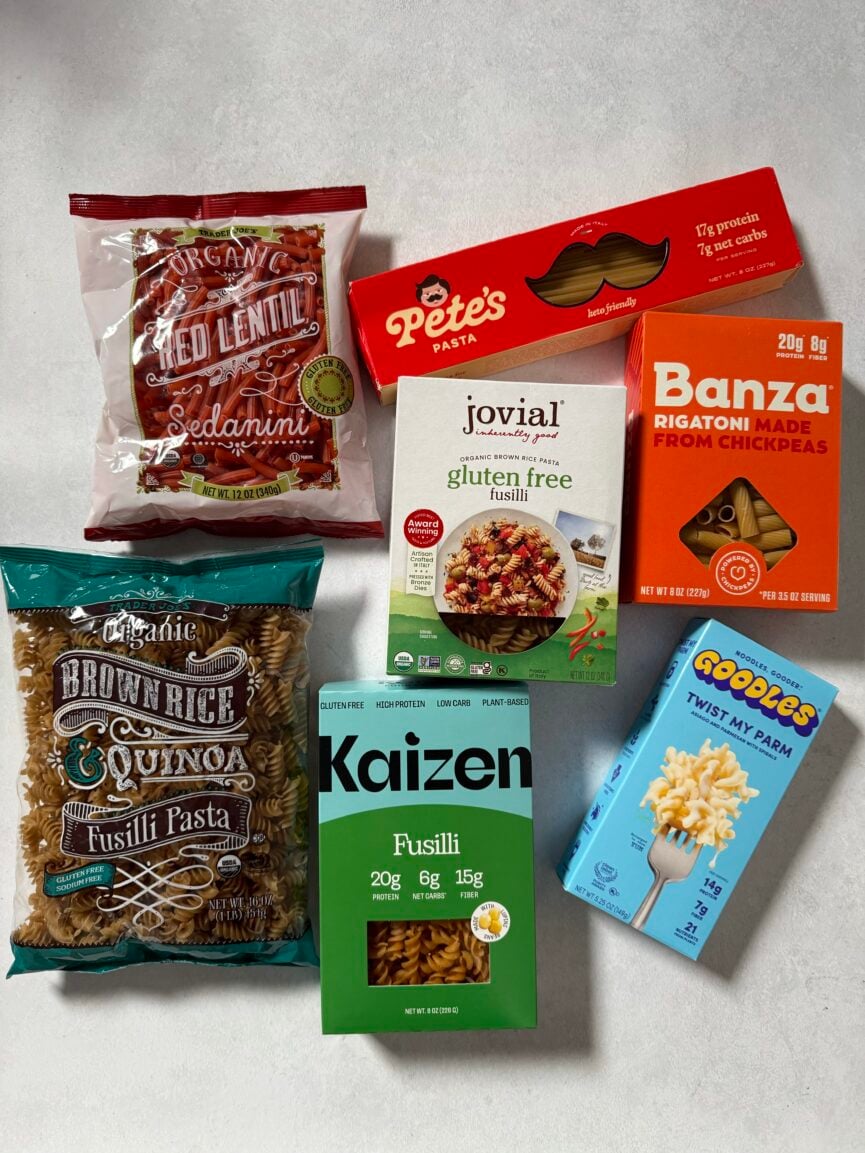
Pasta Roundup—Putting 7 Healthy Pastas to the Test
PSA: finding the healthiest pasta isn’t just about grabbing a box labeled “whole grain” or “protein-packed.” In fact, most of these aren’t any better than their refined counterparts—they’re simply more expensive. But good news! I took matters into my own hands. To help you make informed (but delicious) choices, below are my professional insights.
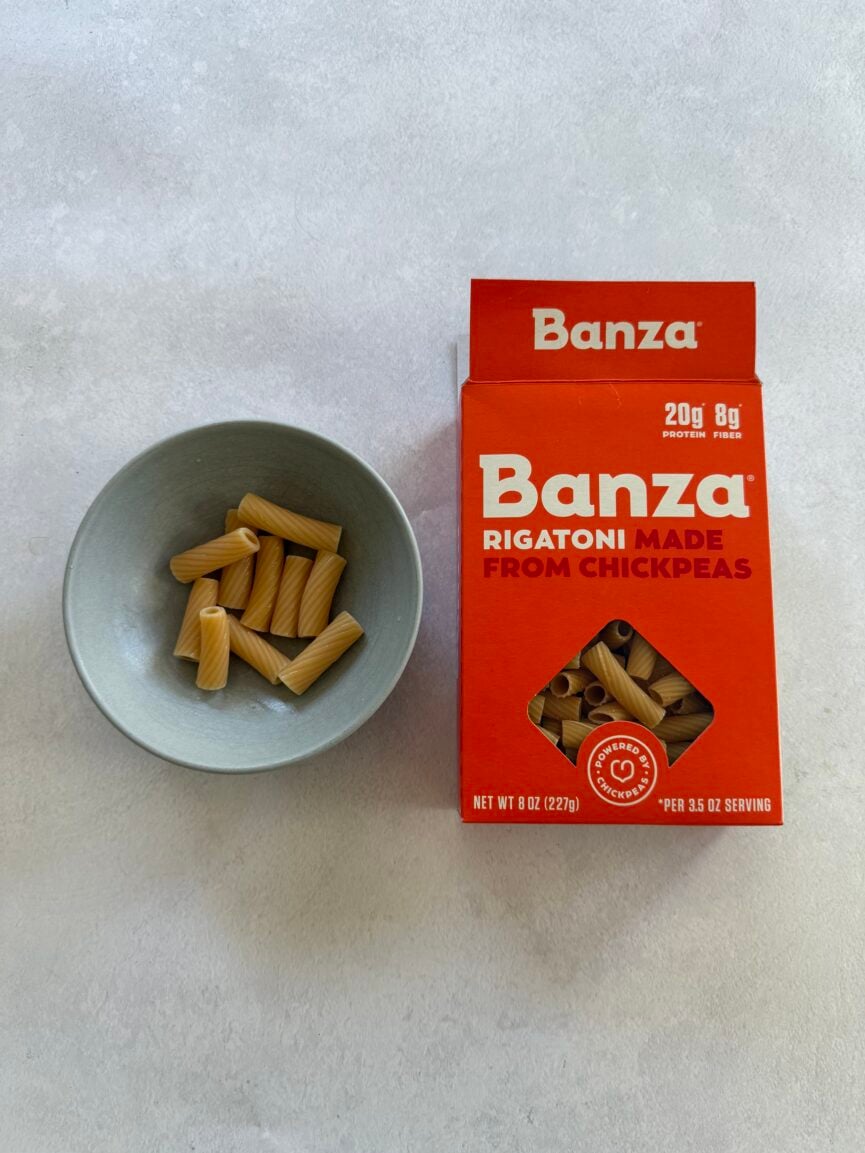
If you know alternative pastas, you know Banza. Banza launched in 2014 and quickly gained popularity for being a gluten-free, high-protein, and fiber-rich option made from chickpeas. They’re one of the pioneers in the healthier pasta sphere and have gone on to create pizzas, waffles, mac and cheese, and rice.
Taste. These noodles are similar enough to regular pasta (my husband can’t tell the difference!), but they can be a bit grainy/chewy. As opposed to al dente, Banza is best well done. In terms of sauce combinations, the sky’s the limit. Try any Banza shapes with one of these vegetarian pastas.
Nutritional Profile. With only four ingredients and 11 grams of protein (plus 5 grams of fiber) per serving, Banza gets my stamp of approval.
Rating. 8/10—Banza pairs well with pretty much any sauce, making it a great substitute if you’re looking for a gluten-free or protein-forward option.
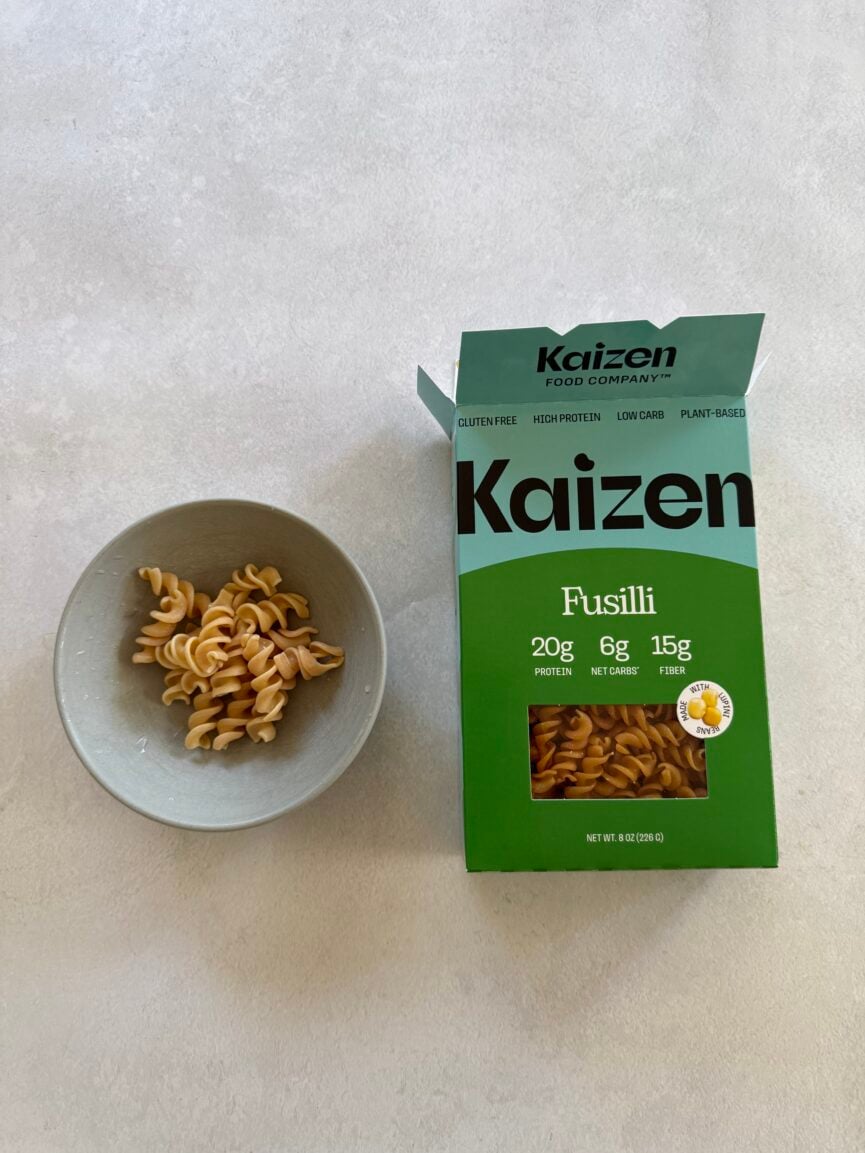
Kaizen pasta is made from lupini beans (a yellow legume). It’s less grainy than Banza and holds its shape well when cooked—but don’t over-boil these noodles! The neutral taste makes it versatile and allows sauces to shine.
Taste. Like Banza, these noodles have a slightly earthy taste and are thicker than other varieties. But doused in this vegan butternut squash pasta sauce, you won’t miss regular noodles.
Nutritional Profile. As far as nutrition is concerned, Kaizen takes the cake. Compared to traditional pasta, these noodles have 85% fewer carbs, 3x the protein (20 grams per serving!), 3x the fiber (15 grams per serving!), and they’re made from non-GMO regeneratively grown lupini beans.
6/10—The texture is a bit gummy (and doesn’t exactly resemble regular pasta), but you get an incredible bang for your nutrition buck with these.
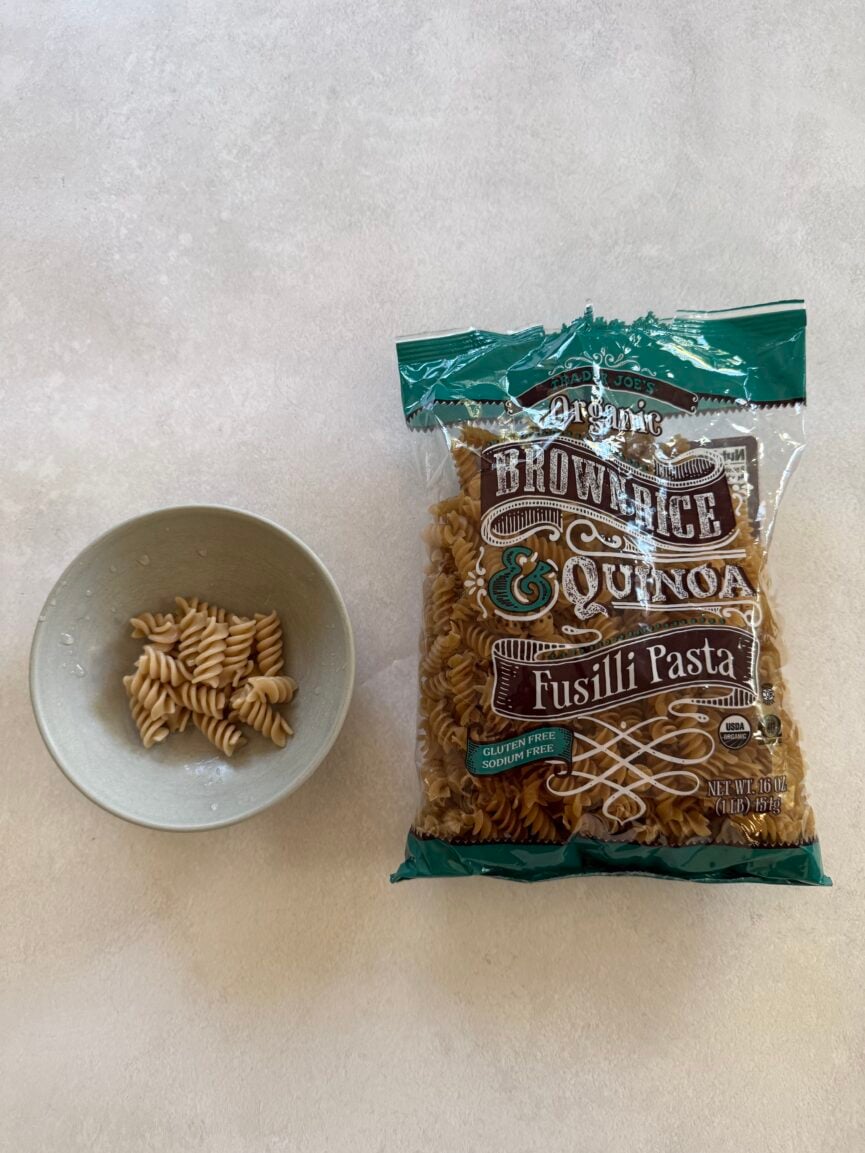
Super popular among gluten-free eaters—and those looking for healthier pasta—TJ’s Brown Rice & Quinoa pasta closely resembles traditional pasta. For TJ’s aficionados, this is a house staple.
Taste. This has a mild, slightly nutty flavor with a smooth, firm texture. In my opinion, it mimics the taste of traditional wheat pasta more so than other alternative pastas! But like Kaizen, it can become a bit sticky or gummy if overcooked. I prefer this pasta with pesto or in chicken noodle soup.
Nutritional Profile. I love that this pasta is organic and only has three ingredients, but it only contains two grams of dietary fiber and three grams of protein per serving. As far as blood sugar balance is concerned, there are better options out there!
7/10—Overall, it’s a solid gluten-free option (for those looking to avoid wheat while still enjoying a familiar pasta experience), but each serving has barely any fiber and is low in protein.
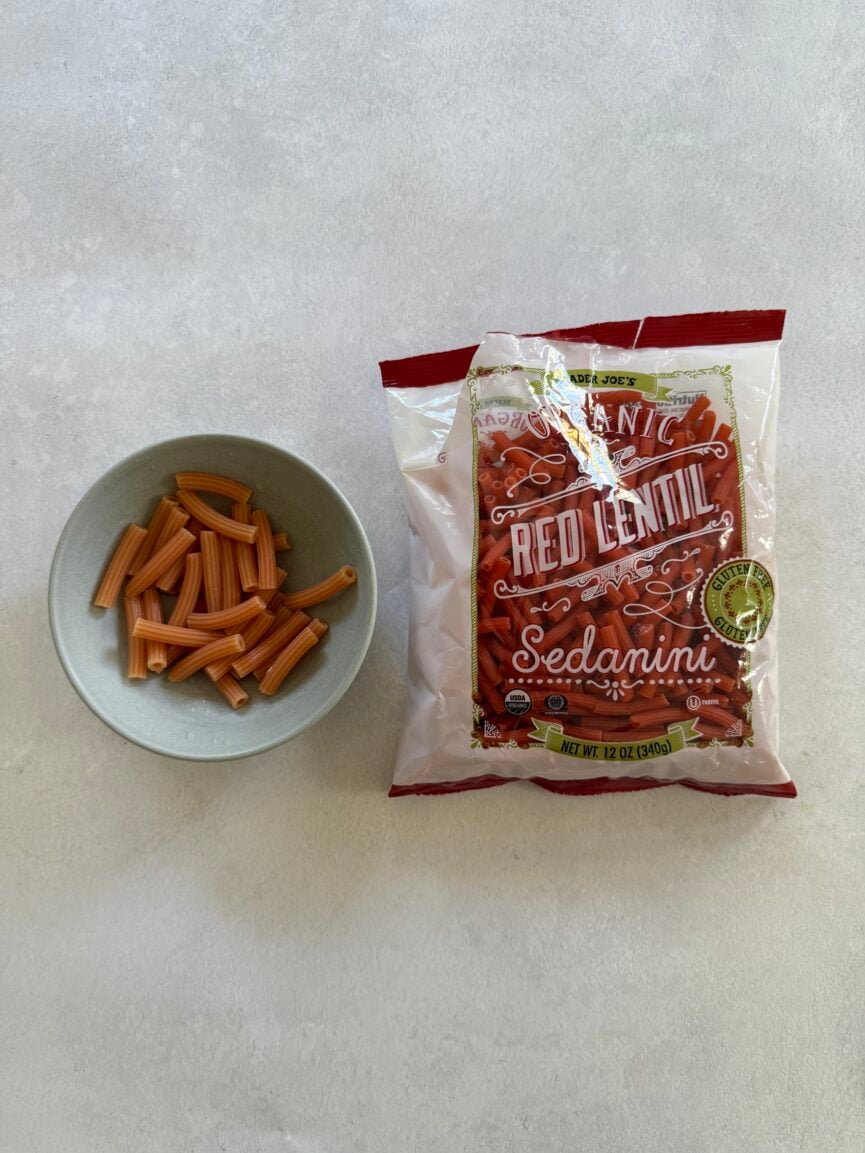
Another TJ’s staple has entered the chat. Yes, this tastes distinctly like lentils but it cooks up like traditional pasta with an al dente texture. Made with just organic red lentil flour (love this), it packs an impressive amount of plant-based protein per serving. Pair it with your favorite tomato basil sauce—or a simple olive oil, garlic, and cheese blend—and dinner comes together in no time.
Taste. It’s slightly nuttier than traditional wheat pasta, but I find it’s still neutral enough to pair well with a variety of sauces and toppings (my favorite way to use it is in a pasta salad). The texture is usually firm, but I’ve noticed that these leftover noodles become quite delicate. Don’t overcook these!
Nutritional Profile. With only one ingredient, six grams of fiber, and 15 grams of protein, this red lentil pasta knocks it out of the (nutrition) park.
6/10—It doesn’t taste like traditional pasta (hence the lower rating), but its nutrition profile is fabulous. If I’m making a hearty vegetarian meal, you can bet TJ’s Red Lentil Sedanini is the star of the show.
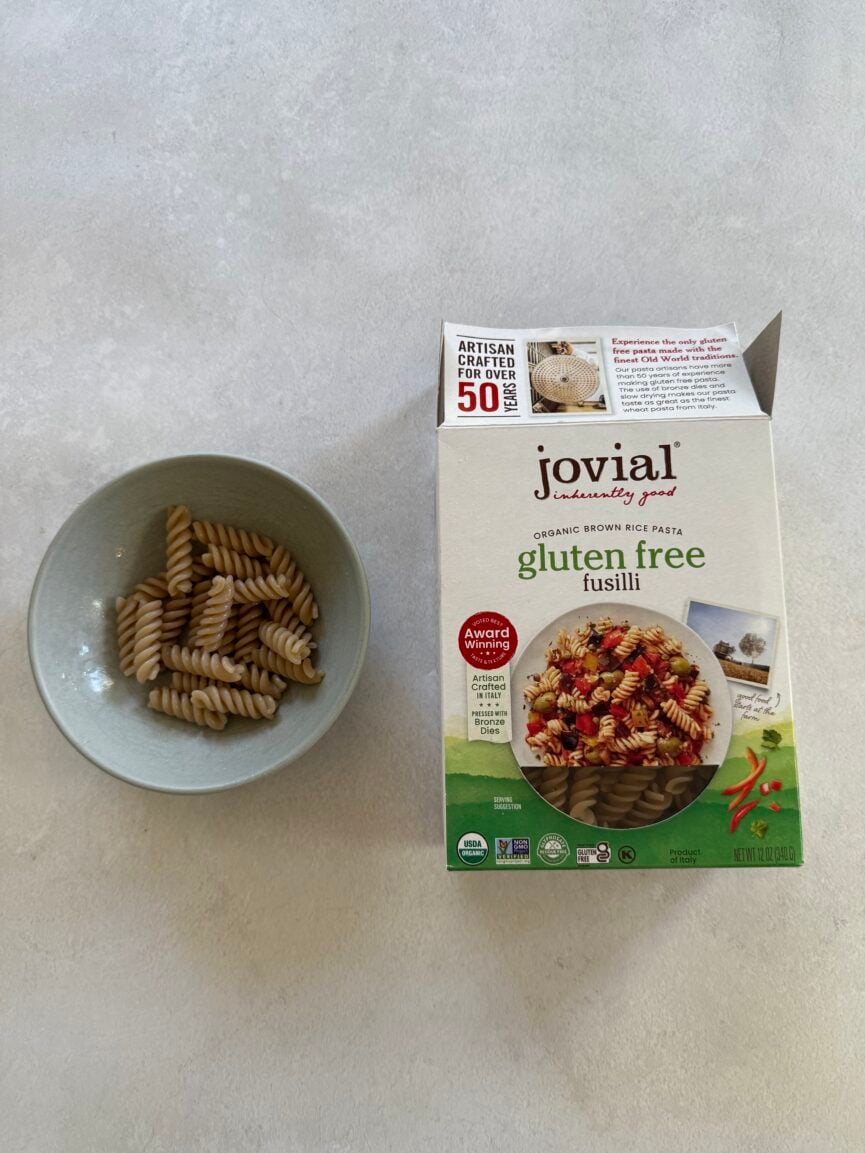
Jovial pasta is a must-try in gluten-free cooking. The taste/texture is phenomenal! I get why people say it rivals traditional wheat pasta. Jovial is certified glyphosate-free, they work directly with small family farms, and their packaging contains zero plastic (win, win, win).
Taste. As far as taste/texture is concerned, this alternative pasta is my favorite. I’ve seen it pop up on social media, and I get the hype. It doesn’t have the same earthy or nutty taste that other alternative pastas have. It works well with a wide range of sauces and dishes—especially this roasted vegetable pasta.
Nutritional Profile. With only two ingredients (organic brown rice flour) and water, this nutrition label passes with flying colors. That said, it’s low in fiber and—in comparison to TJ’s Red Lentil Sedanini and Kaizen—it doesn’t have much protein.
8/10—Like Trader Joe’s Brown Rice & Quinoa Pasta, Jovial’s rendition boasts similar nutrition facts—barely any fiber and a small amount of protein (five grams per serving). However, it gets an 8/10 for texture and taste!
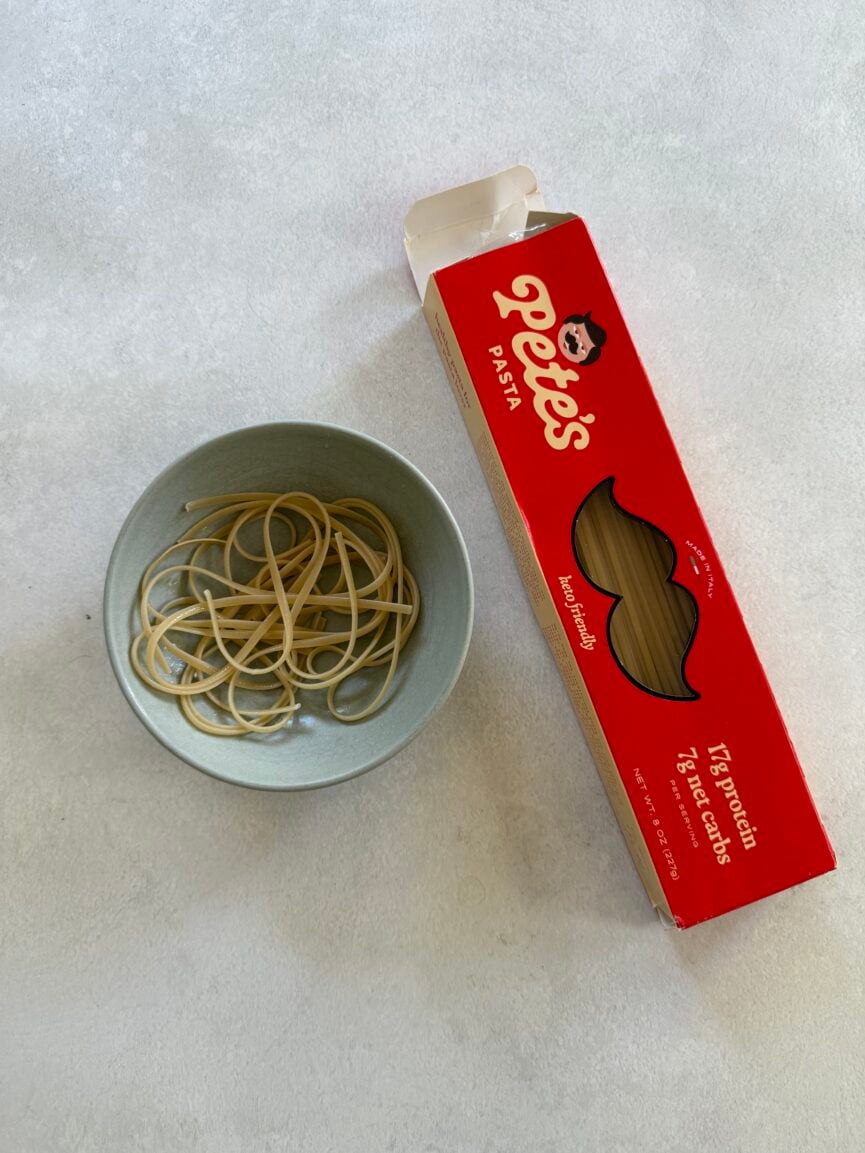
Keto-friendly, low net carb, high-protein, and high-fiber, this pasta is almost too good to be true. Best of all, it’s handcrafted in Italy! Their wheat is made with organic durum semolina and fresh mountain spring water.
Taste. Cue the confetti: this healthier pasta actually tastes like regular pasta. The only noticeable difference is that it takes longer to boil—about 20 minutes. Overall, the texture is smooth and has a fairly neutral taste. It holds up really well too. Try it with this burst tomato pasta or green sauce pasta.
Nutritional Profile. With four ingredients, 27 grams of fiber (more than most people get in a day!), and 17 grams of protein, this pasta is packed with all the good, satiating stuff.
8/10—Despite the long cook time, the taste and texture are excellent! This is a great option for low-carb, protein-forward pasta.
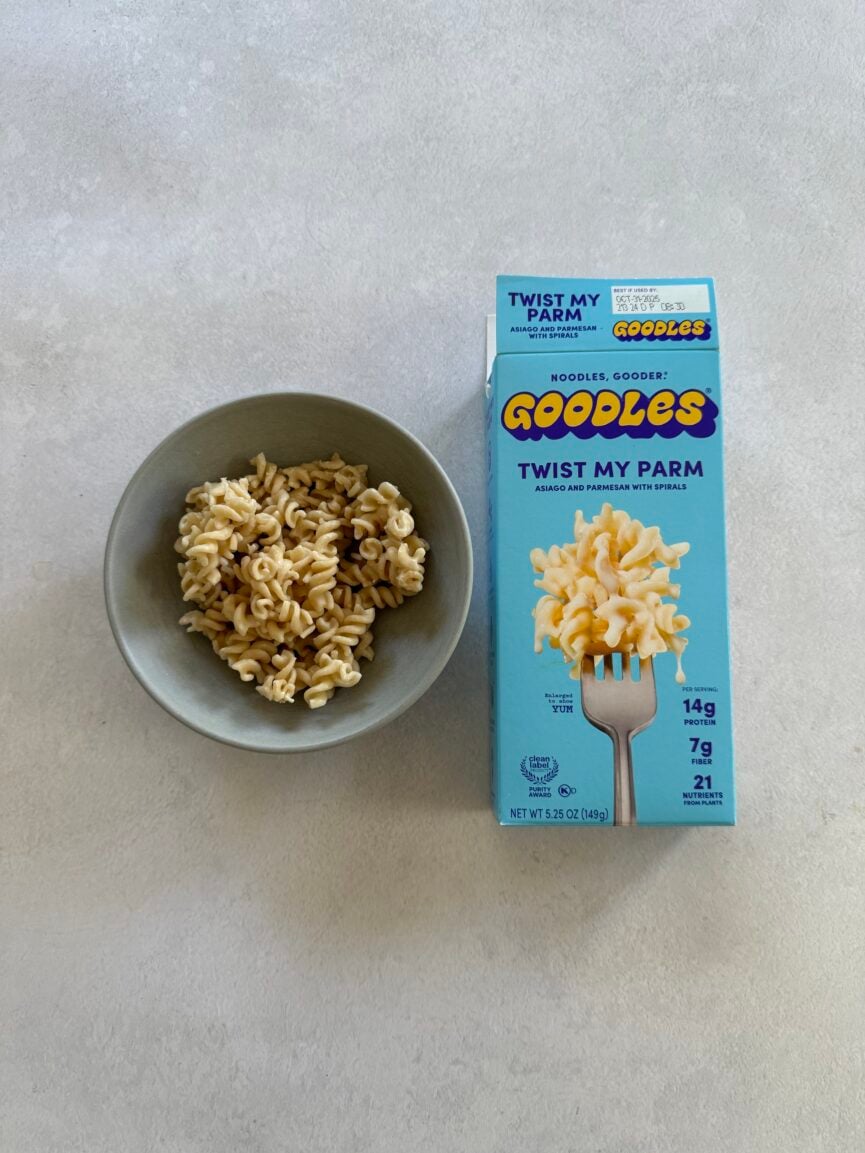
Think of Goodles as a modern twist on traditional mac and cheese. They offer a nutrient-packed noodle made from a blend of ingredients like chickpeas, wheat, and veggies (but they do make gluten-free options as well). In turn, you’re getting more vitamins and minerals than conventional noodles—while still delighting in a creamy, cheesy bowl of goodness. And fun fact: they’re the first boxed mac and cheese ever to receive Clean Label certification.
Along with mac and cheese varieties, Goodles also makes plain noodles as well.
Taste. You can tell Goodles are designed to be both indulgent and nutritious. The noodles have a mild, familiar taste but with a slightly heartier texture than standard pasta. Goodles absolutely deliver on taste and satisfaction.
Nutritional Profile. With seven grams of fiber and 14 grams of protein per serving, along with ingredients like broccoli, spinach, kale, pumpkin, maitake mushroom, and more, they’ve cracked the (noodle) code.
9/10—We love, love, love Goodles. Both of my boys gobble up this mac and cheese, but it’s equally adult-friendly. Paired with chicken sausage and steamed broccoli, dinner comes together in under 20 minutes.

